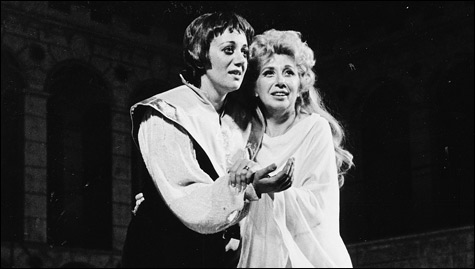
"BOUQUET CATCHER": Tatiana Troyanos as Romeo and Sills as Juliet in Sarah Caldwell’s 1975 production of Bellini’s I Capuleti e i Montecchi.
|
Beverly Sills, the most loved American opera singer of her generation, died this past week from inoperable lung cancer at 78. Her nickname, “Bubbles,” tells much of her story. She was exuberant, irrepressible, effervescent. Smart and funny. And at the height of her 25-year singing career, she had one of the world’s most beautiful voices. “Beverly Trills” (some later critics called her “Beverly Shrills”) was the reigning diva of Sarah Caldwell’s Opera Company of Boston from the early 1960s into the mid ’70s. Her repertoire embraced bel canto, French romanticism, Verdi, Puccini, and contemporary avant garde. I can still see her flaming mop of red hair sticking up over the barricades in Luigi Nono’s 12-tone Intolleranza. In Offenbach’s Tales of Hoffmann, she sang all four soprano leads.
And she always seemed to be having a good time. I’ll never forget her cracking up in The Barber of Seville when the note she dropped from her balcony fluttered waywardly into the orchestra pit. In one production, her tenor was so bad that he refused to take a curtain call; but Sills literally dragged him out from the wings for his bow. Critic Michael Steinberg called her “the kind of woman who actually catches the bouquets that are thrown at her across orchestra pits and footlights.”
Her landmark year was 1966. In Caldwell’s dazzling production of Rameau’s Hippolyte et Aricie (opposite an unknown young tenor named Placido Domingo), Sills astounded the audience with the radiance and effortless agility of her coloratura. Who knew she could sing this kind of music? Then at the New York City Opera, as the witty, seductive, self-knowing Cleopatra in another forgotten 18th-century gem, Handel’s Julius Caesar, she made headlines. After years of being underappreciated, she became an overnight sensation.
She didn’t make her Met debut for another nine years, after Met director Rudolf Bing retired (years later, she herself became chair of the Met board). Among her most admired roles were her portrayals of Donizetti’s Elizabeth I, Mary Stuart, and Anne Boleyn — roles that taxed her light, sparkling voice. Intense and affecting, she also made every character seem motherly — and American.
With her ability — and her power — Sills could have changed the history of opera performance, reviving a lost repertoire of Baroque operas (the way Maria Callas had re-discovered and shed new light on the forgotten works of the early 19th century), or winning a new audience for operetta (some of her recordings are unsurpassed). But she wanted to be a star more than an exploring artist.
She got what she wanted.
Despite personal hardships — an autistic son, a deaf daughter who could never hear her mother sing — Sills seemed like a steamroller (as Isaac Stern called her) who’d never let up. Or ever lose her sense of humor. When she retired from singing, at 51, she told an interviewer: “I wanted people to say ‘You left too soon’ not ‘You left too late.’ ” No one else ever made a serious enterprise like opera seem like so much fun.